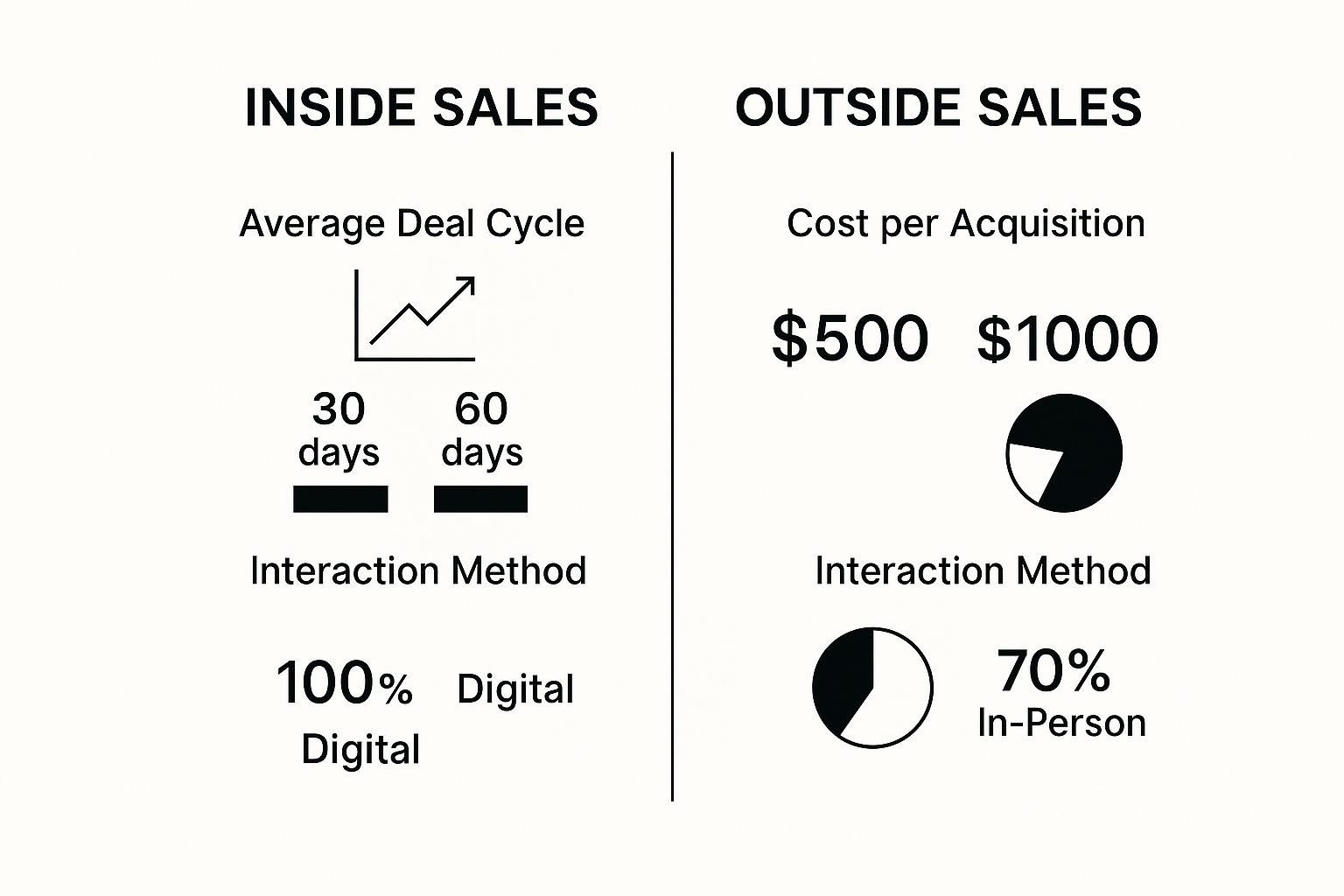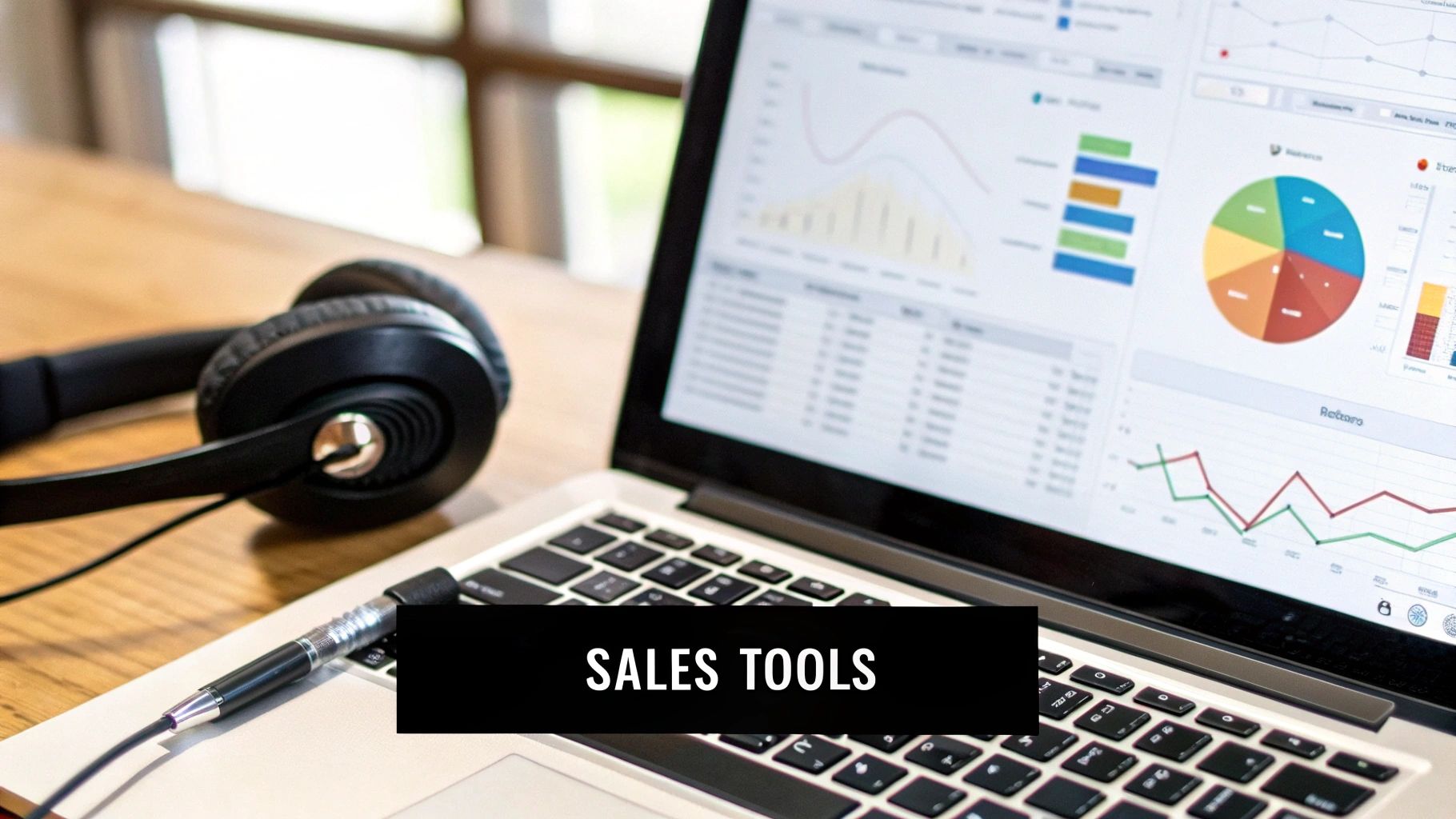Inside sales is simply the process of selling to customers remotely rather than in person. Sales pros use tools like phones, email, and video calls to connect with prospects, run demos, and close deals, all from a central office or even their home. This approach makes selling incredibly efficient and easy to scale as a business grows.
What Is Inside Sales Really?

Forget the old image of a loud, chaotic call centre. A modern inside sales team is more like a strategic command centre for driving revenue. From this hub, they build customer relationships, deliver powerful product demos, and navigate buyers through the entire purchasing process—all without stepping foot outside the office.
The whole model is built on efficiency and reach. By cutting out travel, an inside sales rep can engage with dozens of prospects in the same time it would take an outside rep to have maybe one or two face-to-face meetings. It’s a high-volume, high-velocity approach that runs on technology.
To get a clearer picture, let's break down the essential pillars that define the inside sales model. These are the non-negotiables that make it work.
Core Characteristics of Inside Sales
table block not supported
These elements work together to create a predictable and repeatable sales engine.
Ultimately, this structure lets businesses expand their sales efforts quickly and affordably. It allows them to tap into a wide geographic market from one location, turning sales from a guessing game into a measurable science that fuels predictable growth.
Inside Sales Versus Outside Sales
One of the best ways to get a real feel for inside sales is to see how it stacks up against its more traditional cousin, outside sales. Think of it this way: you have two salespeople. One spends their days connecting with customers from an office using technology, while the other is constantly on the move, meeting clients face-to-face. Their day-to-day realities really shine a light on the core differences.
An inside sales rep’s world revolves around their digital toolkit. They'll start the day diving into their CRM, checking their pipeline, and planning their outreach. The entire day is a high-tempo mix of strategic calls, crafting personalised emails, and running back-to-back video demos for prospects anywhere in the country. It's a game of speed and volume—they can connect with dozens of potential buyers in the time it takes an outside rep to travel to a single meeting.
Now, picture the outside sales rep. Their week is a blur of airports, hotels, and client sites. Success here is built on handshakes and deep, personal rapport, which means a lot of time and money is spent on travel. While these face-to-face interactions are incredibly powerful, they can only realistically meet a few clients each day. The sales cycle tends to be longer, but that personal connection is often what seals the deal for big, complex sales. For anyone in this line of work, there are specific skills needed to succeed, and you can explore some proven field success tips for outside sales representatives to learn more.
This visual comparison highlights some of the key differences in how these two models operate.

As you can see, the inside sales model is really built for efficiency and scale, whereas outside sales doubles down on the depth of the relationship.
Let's break down these differences side-by-side to make it even clearer.
How Inside Sales and Outside Sales Compare
table block not supported
Ultimately, this comparison shows that each model has its own distinct strengths tailored to different business needs and sales contexts.
Choosing the Right Model for Your Business
So, which one is right for you? It’s not about which model is "better"—it's about which one aligns with your product, your market, and your goals. A company selling complex, million-dollar machinery will likely lean on an outside sales team to provide hands-on demos. On the other hand, a SaaS company with a straightforward monthly subscription will thrive with an inside sales team's fast, scalable approach.
Many of today's most successful companies don't even choose one over the other. Instead, they build a hybrid model that gets the best of both worlds. For example, an inside sales team could handle qualifying all incoming leads and closing smaller deals, freeing up the outside sales team to focus their energy on landing the huge, strategic accounts that demand that in-person touch. This kind of integrated strategy lets a business be both efficient and thorough, making sure no opportunity slips through the cracks.
The Career Path and Earnings in Inside Sales

So, what does a career in inside sales actually look like? Far from being just another job, it offers a clear, performance-driven path with serious earning potential. For anyone wondering if inside sales is a legitimate long-term option, the answer is a resounding yes. It’s a field with a well-defined ladder you can climb, built on skill, hustle, and results.
Most people get their start in an entry-level role, often as a Sales Development Representative (SDR) or Business Development Representative (BDR). The mission here is simple but crucial: prospect, prospect, prospect. SDRs are the engine of the sales team, responsible for finding and qualifying new leads to keep the pipeline full. Success is all about activity and hitting your numbers for qualified meetings booked for the closers.
Moving Up the Ladder
Once you've proven you can generate quality leads, the natural next step is to become an Account Executive (AE). This is where you get to close the deals. AEs take the warm leads passed over by the SDRs, run product demos, negotiate contracts, and ultimately, bring in new customers. Your pay cheque is typically a mix of base salary and commission, so your ability to perform directly impacts your bank account.
After you've found success as an AE, the path can branch out depending on your talents and goals.
- Senior Account Executive: Consistently crush your quota? You could step up to a senior role, where you're trusted with the biggest and most important client accounts.
- Inside Sales Manager: If you've got a knack for leadership, moving into management is a popular route. You'll be responsible for coaching a team of SDRs or AEs, setting targets, and steering the whole group toward success.
- Sales Enablement or Operations: Some find their passion in the process itself. These roles focus on making the entire sales machine run better, from developing training programs to implementing new sales tech.
Understanding Compensation
Let's talk money. The financial side of inside sales can be very rewarding. In California, for instance, an Inside Sales Representative earns an average annual salary of around 50,796**. Of course, this number can swing quite a bit based on your industry, experience, and especially your commission plan, with top performers clearing over **72,000. For a closer look, you can check out more details on the earning potential for inside sales roles in California.
This kind of structure creates a high-energy environment where hard work and skill are rewarded in a very real way. It makes inside sales a genuinely lucrative and exciting career for anyone with the drive to succeed.
Building Your High-Performance Sales Workflow
A top-tier inside sales team doesn't run on guesswork. It runs on a solid, repeatable workflow that acts as the engine driving raw leads toward becoming loyal customers. This process gives your team a clear roadmap, makes sure no opportunity falls through the cracks, and lets you fine-tune your performance every step of the way.
Think of it like a well-oiled assembly line. A lead moves from one station to the next, with each stop representing a clear stage in your sales process. Without this kind of organized approach, your reps are just improvising, which leads to chaos, wasted effort, and deals that simply disappear.
Stage 1: Lead Generation and Qualification
It all starts with a lead. This is where a potential customer first raises their hand, maybe by filling out a form on your site, grabbing an ebook, or replying to an email. The goal here isn't to make a hard sell right away; it's to figure out if they're actually a good fit for what you offer.
This initial contact is usually handled by a Sales Development Representative (SDR). Their entire job is to quickly qualify new leads against a set of criteria—a popular framework for this is BANT (Budget, Authority, Need, and Timeline). This filtering step is absolutely critical.
- Connection Rate: What percentage of prospects does an SDR actually manage to speak with?
- Qualification Rate: Of those they connect with, what percentage are a good fit to move forward?
Keeping a close eye on these numbers ensures your Account Executives are spending their time on conversations that have a real chance of turning into revenue.
Stage 2: Nurturing and Demonstration
Once an SDR qualifies a lead, it gets passed over to an Account Executive (AE). This is where the real relationship-building kicks in. The AE’s first task is to get that prospect on a discovery call or a product demo to dig much deeper into their specific problems and what they hope to achieve.
This stage is all about education and showing the prospect what's possible. The AE needs to draw a straight line from the prospect's pain points to your solution, making the presentation all about them.
The handoff from SDR to AE has to be seamless. For more on how to nail this, check out our guide on lead routing best practices, which is packed with strategies for a smooth transition.
Stage 3: Closing and Onboarding
After a solid demo, the prospect is getting close to the finish line. The AE now switches gears to handling objections, negotiating the final terms, and getting that contract signed. It’s a delicate dance that requires skill, persistence, and a solid grasp of the customer’s buying process.
The numbers to watch here are the proposal sent rate and, of course, the close rate. A healthy close rate is a great sign that your team is effectively showing value and that your product is hitting the mark. But the job isn't done when the deal is signed. A smooth handoff to your customer success or onboarding team is the final piece, ensuring your new client has a fantastic experience from day one and setting them up for a long, happy partnership.
The Essential Tech Stack for Inside Sales

For an inside sales team, technology isn't just helpful—it's the entire foundation they operate on. The right tech stack is what allows a remote team to connect with prospects down the street or across the country, nurture those relationships, and close deals with real speed and accuracy. Without these tools, your reps are basically flying blind, bogged down by manual work instead of actually selling.
At the very heart of this setup is the Customer Relationship Management (CRM) system. You can think of it as the team's digital brain or central command centre. It’s the single source of truth that keeps track of every lead, every conversation, and every stage of a deal. Getting a handle on Customer Relationship Management (CRM) basics is non-negotiable for building a successful inside sales operation.
A properly set-up CRM gives everyone, from the newest rep to the head of sales, a crystal-clear, real-time picture of the entire pipeline. No more guessing games.
Core Components of the Stack
While the CRM is the star of the show, a high-performing inside sales team needs a few other key technologies playing backup. These tools need to talk to each other, creating a smooth workflow that sends productivity through the roof.
- Communication Platforms: These are your direct lines to prospects. This includes Voice over IP (VoIP) phone systems for making calls right from a computer, plus video conferencing tools for running engaging product demos and having virtual face-to-face meetings.
- Email Automation Tools: Let's be real, reps can't manually email hundreds of prospects and keep their sanity. Automation software lets them schedule personalized follow-up sequences, nurture leads over weeks or months, and track who's opening and clicking to see what messages are actually landing.
- Sales Intelligence Software: These platforms are a rep's secret weapon. They dig up valuable data on prospects and their companies before the first call is even made. This intel allows for sharply personalized outreach that speaks directly to a buyer's unique problems and goals.
Choosing the Right Tools
The exact tools you pick will hinge on your team's size, your specific sales process, and, of course, your budget. But the end goal is always the same: give your team a connected system that makes their job easier and more impactful. Many platforms now offer all-in-one solutions that bundle several of these functions together.
When you're looking at different options, make sure you choose software that can grow with you. To get a better sense of what's out there, you can explore some of the 10 best lead management software options and see how different systems are built to tackle specific sales challenges. At the end of the day, the right technology is what turns a good sales process into a great one.
Actionable Best Practices for Sales Success
Having a solid workflow and the right tech is a great start, but what truly separates the top performers in inside sales is how they execute. It’s not about robotically following a script; it’s about mastering the human-to-human skills that build real trust and drive results, whether you’re on the phone or a video call. These are the practices that turn an average rep into a genuine closer.
It all starts with active listening. This isn't just about waiting for your turn to speak. It’s about truly hearing the problem behind the prospect's words. Pay close attention to their tone, any hesitation, and the specific phrases they use. Instead of just launching into your pitch, ask thoughtful, open-ended questions like, "Could you walk me through how that affects your team's day-to-day?" This is how you uncover the real pain points.
When you understand someone on that level, you can move on to the next critical practice: making it personal.
Personalise Every Interaction
It’s easy to slip into a generic pitch when you're making dozens of calls a day. But buyers can spot a cookie-cutter approach from a mile away. In fact, studies show that 80% of customers are more likely to buy from a company that provides a personalised experience.
And I'm not just talking about using their first name. Real personalisation means you’ve done your homework. Reference a recent company announcement you saw, mention a shared connection on LinkedIn, or, most importantly, tailor your product demo to solve the exact challenges they just told you about. This instantly builds your credibility and shows you’re invested in their success, not just your quota.
Master the Virtual Demonstration
For an inside sales rep, the product demo is your time to shine. A great virtual demo isn't a boring tour of every feature. It's a story, and the prospect is the hero.
Here are a few simple rules for a demo that actually converts:
- Start with their pain. Always kick things off by recapping the challenges you just discussed. This immediately frames the entire presentation around what matters most to them.
- Show, don’t just tell. Don't list features. Instead, demonstrate exactly how your product solves their specific problem in real time. Connect every single click back to a clear benefit for their business.
- Keep it a conversation. Pause frequently to ask questions. Something like, "Can you see how this would help your team with X?" keeps them engaged and confirms the value is landing.
Finally, learn to welcome objections. Don't be afraid of them. An objection is usually just a disguised request for more information. Listen carefully, validate their concern ("That's a fair question…"), and then provide a clear, confident answer that reframes the issue and brings the focus back to your value. Nailing these skills will take your performance to the next level and turn more of your conversations into closed deals.
Got Questions About Inside Sales? We’ve Got Answers.
Even after getting the basics down, you might still have a few practical questions kicking around as you think about bringing an inside sales model into your business. Let's tackle some of the most common ones to clear up any confusion.
A big one we hear is, "Isn't this just for tech companies?" While it’s true that the SaaS world really put inside sales on the map, its reach has exploded. Today, you'll find successful inside sales teams in finance, logistics, professional services, and even manufacturing. The real test isn't the industry, but whether you can sell your product effectively without needing a physical, in-person handshake or demonstration.
Another point of confusion is how inside sales is any different from telemarketing. They couldn't be more different.
The key is to see your inside sales reps as strategic consultants, not just people dialling a phone.
Is Inside Sales a Good Fit for My Business?
Figuring out if this model makes sense for your company really boils down to a few core factors. Ask yourself these questions to see if it aligns with your products and goals.
- How Complex Is Your Product? Can you get the value across with a sharp video demo and a great conversation? If the answer is yes, inside sales is definitely a strong possibility.
- What's Your Average Deal Size? There's no hard-and-fast rule here, but inside sales really shines with small to mid-sized deals. For these, the cost of sending a field sales rep on a plane just wouldn't make financial sense.
- How Long Is Your Sales Cycle? Are you closing deals in weeks instead of years? The faster pace of inside sales is built for these shorter, more dynamic sales cycles.
At the end of the day, the scalability and efficiency of this model are what make it such a powerful way to grow. Being able to connect with a huge audience from a single office—without the massive overhead of travel—is a game-changing advantage in almost any market.
Ready to bring structure and clarity to your sales process? LeadFlow Manager provides the essential tools to manage leads, track performance, and automate follow-ups, giving your sales team the power to close more deals. See how our platform can help you grow at https://leadflowmanager.com.
